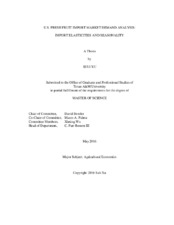| dc.description.abstract | U.S. has consistently been the net importer of fresh fruit over decades. Studies suggest that the demand for fresh fruit will continue to increase because of the globalization of markets and U.S. policies. However, the structure of the import mix has changed dramatically, between 1990-92 and 2010-12. The striking changes of value share are apparently caused mainly by the preference change of consumers, further elasticity estimates, as the indicator of consumers’ preference for most fresh fruits, are outdated and or nonexistent. Outdated import elasticities will cause problems in estimating the quantity changes, since the incomes and market fundamentals may have already changed. Seasonality is an import characteristic for the fruit market, the analysis of seasonality could help producers and market managers identify the market competition and opportunities. The seasonality change is analyzed mainly based on five-year monthly average of domestic production and imports amount between1990-94 and 2010- 14. Import elasticities are estimated based on a Nonlinear AIDS model. Through the seasonality analysis, we find the domestic production season had no significant change between 1990-94 and 2010-14, whereas, the import window expanded its length. Imports had no significant sign to compete with domestic production during domestic production season, on the contrary, imports have supplemented domestic production during off-season to meet increased U.S. demand. The estimation results show that the imported fruits are also priced inelastic at market level. Imported grapes are the only luxury good (relative to their expenditure elasticities). When expenditures increase, people prefer more imported grapes and less imported apples. Issues of endogeneity and import versus domestic elasticities are identified but left for future research. | en |


